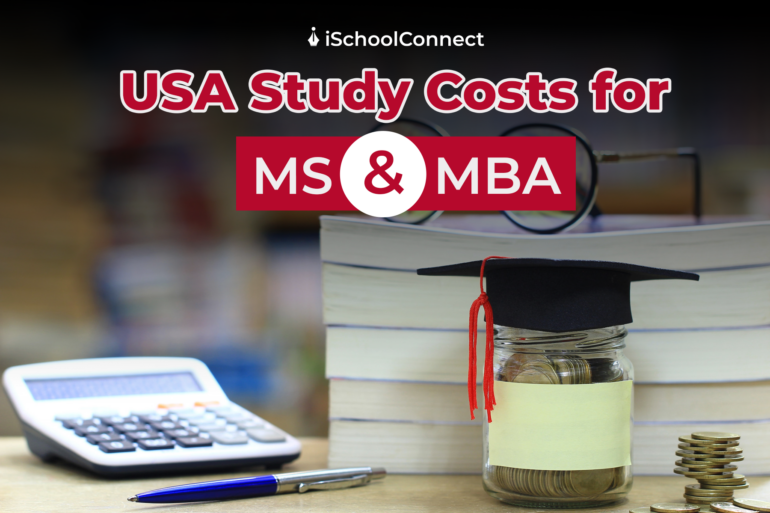Table of Contents
A holistic approach to studying in the United States
Setting out to pursue higher education in the United States is an exciting and demanding task. Students pursuing an MS or MBA must contend with the financial challenges of living and studying abroad and the academic demands. The goal of this blog is to give readers a thorough overview of the cost of living and studying in the United States. It addresses a number of topics, including housing, food, transportation, personal expenses, and so on.
Cost of living
The cost of living in the USA varies significantly based on the city and lifestyle. Generally, major cities such as San Francisco, New York, and Los Angeles tend to have a higher cost of living compared to smaller or rural cities. It’s crucial for students to factor in these differences when planning their budgets.
International students should budget between $10,000 and $25,000 a year, or $1,000 to $2,000 (approx) per month, to live in the United States. This covers the cost of your lodging, room and board, meals, transportation, textbooks, weather-appropriate attire, and entertainment.
Beyond tuition fees, students must consider additional expenses associated with their education. Textbooks, course materials, and other academic resources can contribute significantly to the overall cost of studying. It’s advisable to budget for these expenses in addition to tuition fees.
Other expenses

Here are the expenses that students might have to consider other than tuition fees.
- Housing expenses: One of the most significant components of the cost of living is housing. Whether you choose on-campus housing, off-campus apartments, or shared accommodation, it’s essential to research and budget accordingly. Rental prices vary widely across cities, and the proximity to the university can also impact costs.
- Food and groceries: Managing your food budget is crucial for maintaining a healthy and balanced lifestyle. While eating out occasionally is a nice treat, preparing meals at home can be more cost-effective. Local grocery stores and farmers’ markets often offer affordable options for fresh produce, allowing students to strike a balance between convenience and savings.
- Transportation: The total expenditure for transportation can vary depending on the city and its public transportation system. Some cities have well-developed public transit networks, while others may require students to invest in a car. Considering alternatives, such as biking or walking, can also contribute to cost savings.
- Personal expenses: From clothing and toiletries to entertainment and leisure activities, personal expenses lead to a wide range of costs. Creating a monthly budget for personal expenses helps students allocate funds appropriately and avoid overspending.
- Medical expenses: Healthcare in the USA can be expensive, and having adequate health insurance is essential. Most universities offer health insurance plans for international students, and it’s crucial to understand the coverage provided. Budgeting for unforeseen medical expenses is a prudent financial strategy.
Estimation of cost of living in the US
Based on various expenses, the estimated cost of living for students in the United States is provided in the table below.
| Expenses in USA | Average yearly / Monthly cost |
| Accommodation | $9,800 – $11,100 per year |
| Books and study material | $900 – $2,000 per year |
| Clothes | $500 per year |
| Electricity | $100 – $150 per month |
| Food | On campus: $250 per monthOff-campus: $400 – $600 per month |
| Phone subscription | $50 per month |
| Home internet | $45 – $50 per month |
| Health insurance | $700 – $1,100 per year |
| Phone subscription | $50 per month |
| Travel | $300 – $700 per year |
| Water | $50 – $75 per month |
Note- Within the US, these amounts might vary from state to state.
Tips to save money in the USA
Here are a few tips to save money that international students can follow while staying in the USA.
- Create a budget- Develop a detailed monthly budget that includes all anticipated expenses. This will help you keep track of your spending and identify areas where you can cut costs.
- Cook at home- Eating out frequently can quickly deplete your budget. Learning to cook simple and nutritious meals at home can save you a significant amount of money.
- Utilize student discounts- Many businesses offer discounts to students. Whether it’s for transportation, entertainment, or shopping, always inquire about available student discounts to maximize savings.
- Buy used textbooks- Textbooks can be expensive, but buying used or digital versions can significantly reduce costs. Consider renting textbooks when possible and explore online platforms for affordable alternatives.
- Take advantage of free events- Universities and communities often host free events, lectures, and performances. Embracing these opportunities for entertainment can help you save money while enriching your cultural experience.
- Share expenses- If possible, consider sharing housing and transportation expenses with fellow students. This collaborative approach can lead to substantial savings on rent, utilities, and commuting costs.
Key takeaways
- Successfully navigating the academic journey in the USA requires a holistic financial approach. Aspiring students must consider various factors, including housing, food, transportation, personal expenses, and medical costs, to ensure a well-rounded budget.
- Practical tips, including creating a budget, cooking at home, utilizing student discounts, buying used textbooks, attending free events, and sharing expenses with fellow students, empower students to make informed financial decisions and maximize savings
- By adopting a proactive and informed approach to financial planning, students can confidently tackle the challenges of living and studying in the USA, ensuring a fulfilling and successful academic experience.
Please share your thoughts, questions, or experiences in the comments section below. Have more questions or need personalized guidance on your educational journey in the USA? Click here to contact us. We’re here to assist you every step of the way.
Liked this blog? Read next: Features of Finland’s education system | All you need to know
FAQs
Q1. How much bank balance do I need in my account for a US student visa?
Ans- A minimum of USD 10,000 or INR 833,120 bank balance is required, and the bank statements from the previous six to nine months must reflect this amount.
Q2. What are some common mistakes to avoid when budgeting for living expenses in the USA?
Ans- Avoid underestimating costs, neglecting emergency funds, or overspending on non-essential items. Regularly review and adjust your budget to ensure it reflects your evolving financial situation.
Q3. How do I handle currency exchange rates?
Ans- Stay informed about exchange rates and consider using services with favorable rates. Plan larger transactions strategically and explore options for minimizing currency exchange-related losses.






